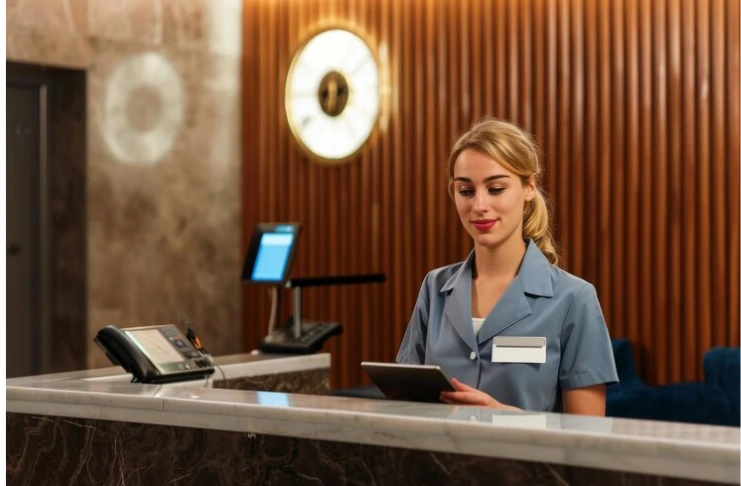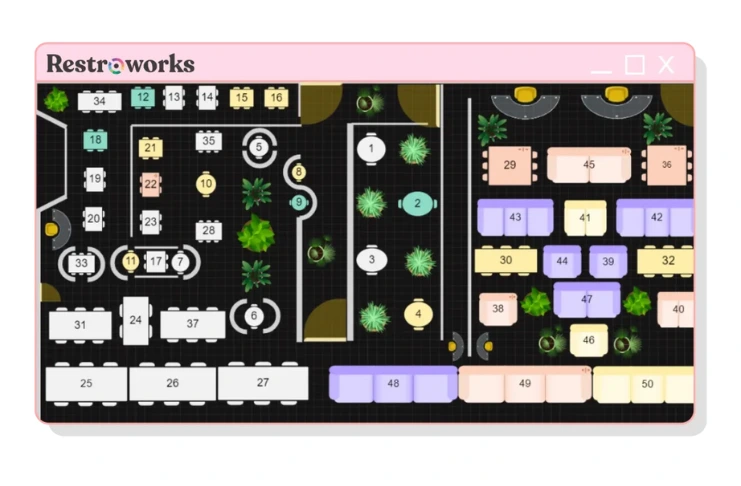
Table of Contents
ToggleManaging a restaurant is no easy feat. Restaurant managers need to balance customers in and out of their restaurants while creating a welcoming and fun environment that ensures customers repeat. This strategy demands proper table arrangement and effective coordination between front-of-house and kitchen staff to ensure customers are neither rushed through meals nor left waiting for long, which can reduce turnover. This is where table management software comes into play.
Table management software helps restaurants handle reservations efficiently, optimize seating, and enhance the dining experience. By streamlining operations, the technology allows staff to focus on what they do best—providing excellent service and delicious food. In this blog, we’ll explore how table management software transforms the restaurant industry, making dining out smoother and more enjoyable for everyone.
What is a Restaurant Table Management System?
A Restaurant Table Management System is software designed to streamline the process of managing tables and reservations in a restaurant. The system streamlines the process of allocating seats, tracking the status of each table (whether it’s occupied, reserved, or available), and managing customer waitlists. It helps restaurant staff efficiently monitor guest flow and optimize turnover rates, all while improving the dining experience and restaurant operations.
Main Features of a Restaurant Table Management System

The key features of a restaurant table management system include:
- Table Layout Visualization: This feature provides a digital representation of the restaurant’s floor plan, allowing staff to see the layout of tables in real-time. It helps manage seating arrangements efficiently, ensures optimal space use, and enhances the overall dining experience. Staff can quickly identify which tables are occupied, reserved, or available, making it easier to accommodate guests promptly.
- Reservation Management: It streamlines the process of booking tables. Customers can make reservations online or through an app, and the system automatically updates the availability. This feature helps reduce double bookings and no-shows by sending reminders to customers. This feature further helps set up time slots and assign tables to customers, ensuring a smooth flow of guests.
- Waitlist Management: Managing a waitlist can be challenging, especially during peak hours. A table management system simplifies this process by allowing staff to add guests to a digital waitlist, keep track of customer information, estimate wait times, and notify customers via text or app when their table is ready. It also helps restaurants keep track of high-demand times and plan accordingly.
- Analytics and Reporting: Analytics and reporting features provide valuable insights into the restaurant’s operations. These tools can track various metrics such as seating capacity, table turnover rates, peak dining times, and customer preferences. By analyzing this data, restaurant managers can make informed decisions about staffing, menu adjustments, and promotional strategies. This feature helps identify trends, optimize restaurant operations, and enhance customer experience.
Choosing the right table management system can revolutionize your restaurant operations. This decision requires a thorough understanding of your specific needs and challenges. Start by assessing: Are you or your team facing issues with table assignments, reservations, or waitlist management that could be resolved with better tools? In-depth analysis and research with your staff about their daily challenges can help you identify your operational needs.
This section has compiled a list of the 12 top restaurant table management systems, including their pros, cons, benefits, and user ratings, to help you select the software that best suits your business needs. Discover which tool can elevate your restaurant’s efficiency and customer experience!
Top Restaurant Table Management Systems: A Comprehensive Guide
1. Restroworks

Key features
- Track table status: This lets restaurants see which tables are occupied, available, or reserved in real-time.
- Manage reservations: Enables restaurants to take reservations online or by phone and seat guests upon arrival.
- Improve table turnover: Helps restaurants seat more customers and increase revenue by optimizing table usage.
- Waitlist management: Restroworks send automated alerts and notifications to guests through SMS or email on the waitlist when their table is ready or provides updates on estimated wait time changes. This functionality is critical in reducing customer wait times and preventing missed reservations, a common issue in busy restaurants.
- Table layout: The versatile customization tool helps you design your floor plan easily. You can add, remove, or edit tables on the floor plan to reflect any changes in your restaurant’s layout. Also, Intuitive color-coded layout is available, using which restaurants can efficiently distinguish vacant, occupied, and billed tables for restaurant management.
Pros: Restroworks offers a comprehensive suite of tools for various aspects of restaurant management. Its user-friendly table layout interface and robust customer support make it a reliable choice for many restaurants. The software’s ability to integrate order-taking, billing, and inventory control helps streamline operations and improve efficiency.
Cons: Complex for smaller businesses.
Pricing: Custom pricing based on specific requirements.
Industry ratings: 4.8/5 on G2 (Based on 961 reviews)
2. Revel Systems
Key features:
- Order Management Queue: Categorize and manage orders based on order channel, status, and more.
- Visual Table Management: Replicate your restaurant’s floor plan on the POS for efficient order assignment and distribution.
- Color-Coded Timers: Easily track the stage of service for each table.
Pros: Revel Systems Table Management helps restaurants improve their table management by allowing them to see a real-time view of their floor plan and which tables are occupied, available, or reserved. This can help restaurants seat guests more quickly and efficiently and avoid overbooking tables.
Cons: Revel Systems can be complex to set up, and restaurants may need to pay for professional installation. It is also a more expensive POS system than some of its competitors.
Pricing: Starts at $99 per month per terminal.
Industry ratings: 4.1/5 on G2 (Based on 143 reviews)
3. Clover
Key features:
- Table Monitoring: Assign tables, split checks, and track table status in real-time.
- Tableside Management: Take accurate orders and control course timing efficiently with tableside ordering and firing.
- Digital Table Mapping: Streamline reservations, seating, and waitlist management.
Pros: Clover offers competitive pricing and a free 30-day trial, making it accessible for many businesses. It provides 24/7 support and integrates well with existing online stores, making it a versatile choice for various restaurants.
Cons: The upfront hardware costs and additional fees for advanced features can be high.
Pricing: Starts at $14.95 per month.
Industry ratings: 4.0/5 on G2 (Based on 81 reviews)
4. Eat App
Key features:
- Searchable list: See reservations as a digital guest book. Search, highlight, and change reservations quickly in a list format.
- Smart grid: A smart grid helps you manage tables with kitchen capacity by organizing reservations by 15-minute time slots. It’s also a super fast way of adding new bookings you receive by phone or walk-in.
- Timeline view: View reservations and tables in a timeline for each shift. Easily fill more of your floor with a bird’ s-eye view of all your tables and seating times on one screen.
Pros: Eat app is a fully integrated table management system with your reservations and guest CRM. It’s the complete front-of-house toolkit to seat more guests, turn more tables, and get more revenue from your existing floor.
Cons: This platform can be slow, especially during peak times or when handling many reservations.
Pricing: Starts at $49 per month.
Industry ratings: 4.5/5 on G2 (Based on 13 reviews)
5. Lightspeed Restaurant
Key features:
- Color-Coded Table Indicators: Visually track table status with color-coded indicators (e.g., free, occupied, ready to pay).
- Dynamic Table Management: Add or remove tables on the fly to accommodate the rush.
- Customizable Floor Plan: Use custom images to represent your restaurant’s specific layout, including tables, seats, and decor.
Pros: The Lightspeed software updates table status, orders, and payments in real-time, allowing staff to manage operations efficiently. It also offers a mobile app for managing restaurant operations from anywhere.
Cons: While the interface is generally user-friendly, some users may need more time to learn all the features. Also, Some plans may require long-term contracts, which might not be ideal for all businesses.
Pricing: Starts at $69 per month.
Industry ratings: 4.4/5 on G2 (Based on 52 reviews)
6. OpenTable
Key features:
- Table assignment recommendations: The system helps restaurants optimize seating arrangements by recommending tables that best fit incoming reservations or walk-in customers.
- Waitlist Management: Offer a waitlist, provide guests with wait time quotes, and text them when their table is ready.
- POS Automatic Table Statusing: It integrates with your Point-of-Sale system, automatically updating table status as orders are placed or closed. This allows for real-time tracking of table availability.
Pros: OpenTable is a powerful tool for managing restaurant table bookings. It offers robust marketing options, an easy-to-use interface, comprehensive CRM capabilities, and data extraction and reporting. Once set up, OpenTable can significantly reduce the manual effort in managing reservations.
Cons: The initial setup process can be complex, and while the interface is generally user-friendly, some users may find it challenging to navigate initially.
Pricing: Starts at $149 per month plus a per-cover fee.
Industry ratings: 4.4/5 on G2 (Based on 203 reviews)
7. SevenRooms
Key features:
- Predictive Waitlists: Reduce stress on FOH staff by setting up predictive waitlists that guests can track.
- Integrated Guest Management: Manage reservations, waitlists, guest lists, and online orders from a single host station tablet.
- Real-time Table Tracking: Monitor table statuses and real-time spending to ensure efficient operations and identify areas for improvement.
Pros: It offers a comprehensive solution for managing reservations and gaining valuable insights into customer behavior. Its flat-fee pricing allows you to better understand your monthly spending.
Cons: SevenRooms may not be as widely recognized as some industry-standard reservation systems. This could potentially lead to risk of lost reservations if customers are unfamiliar with the software.
Pricing: Custom pricing based on specific requirements,
Industry ratings: 4.7/5 on G2 (Based on 52 reviews)
8. Resy
Key features:
- Custom Reservation Inventory: This provides exclusive access to reservation options and allows customers to select a table type during the booking process.
- Automated Table Optimization: Resy’s system automatically optimizes table combinations to maximize seating efficiency and minimize wait times.
- Multi-Device Access: Manage reservations and table assignments from any device, ensuring seamless operations regardless of location.
Pros: Resy offers a user-friendly interface for managing reservations, allowing you to track bookings easily through the app and email notifications. The biggest advantage of their diner network is that they don’t charge cover fees and instead operate on a flat-rate model.
Cons: It lacks advanced marketing automation features. This means you need to manually segment your guest database and create email campaigns to engage your diners.
Pricing: Starts at $249 per month.
Industry ratings: 4.5/5 on Software Advice (Based on 20 reviews)
9. Tock
Key features:
- Automated Table Management: Tock’s system automates table assignments, reconfigurations, and pacing controls, helping restaurants optimize table usage and maximize revenue.
- Flexible and Slot-Based Table Management: It can define specific reservation time slots and manage tables based on those slots.
- Adjustable floor plan: You can easily modify your floor plan to accommodate last-minute reservations or changes in seating arrangements.
Pros: Its ease of use and flexibility make it suitable for restaurants, wineries, and hotels. The platform’s advanced table management features help maximize profitability by optimizing seating arrangements and reducing no-shows through ticket-based reservations.
Cons: One of Tock’s main drawbacks is the additional fees for add-on solutions beyond basic reservations, such as events and takeout, which can add up quickly.
Pricing: Starts at $79 per month.
Industry ratings: 4.2/5 on G2 (Based on 95 reviews)
10. Toast
Key features:
- Automated Seating: Toast uses built-in cover counts and “next up” rotations to assign tables to servers automatically.
- Loyalty Program Integration: Encourage customer loyalty by integrating sign-up prompts into waitlists and reservation confirmations.
- Guest Notes and Preferences: Capture guest preferences and notes to anticipate their needs and provide personalized service. Use automated notifications and two-way messaging to communicate changes with guests and help you avoid no-shows.
Pros: The system’s table management features are intuitive and help streamline operations, making it easier for staff to manage seating and reservations efficiently.
Cons: While Toast Tables is a promising platform, it has certain limitations and cannot offer payment processing options, upgrades, or add-ons through the widget.
Pricing: Starts at $69 per month.
Industry ratings: 4.2/5 on G2 (Based on 302 reviews)
11. TouchBistro
Key features:
- Intuitive Floor Plan Management: Easily create and modify your restaurant’s floor plan with just a few clicks, and changes automatically sync with your in-venue floor plan.
- Seamless Table Transfers: Allow guests to switch tables without disrupting service or losing orders, improving the overall guest experience.
- VIP Treatment with Reservations: Integrating with TouchBistro Reservations allows you to give expected guests VIP treatment by assigning them to the best seats in the house.
Pros: Users can create and edit floor plans, assign customer seats, and split checks. They can also color-code sections of the floor plan to quickly identify which tables belong to which server.
Cons: Its hardware compatibility is challenging, as it is limited to iOS devices, which may restrict choice for some establishments.
Pricing: Starts at $69 per month.
Industry ratings: 4.3/5 on G2 (Based on 105 reviews)
12. Yelp Reservations
Key features:
- Waitlist Management: Yelp allows to efficiently manage waitlists during peak times and Yelp Kiosk offer guests the convenience of self-check.
- Customizable Floor Plan: Create a customized floor plan to accurately represent your restaurant’s layout.
- Two-Way Messaging: Enable seamless communication between staff and guests for updates and inquiries.
Pros: Yelp’s system provides reliable wait time estimates and helps reduce no-shows, improving efficiency for both customers and restaurants. Moreover, the reservation system is included within the Guest Manager suite of management tools, eliminating additional costs.
Cons: While Yelp Reservations offers a solid foundation for reservation management, it may be less suitable for restaurants seeking advanced CRM features, comprehensive reservation functionalities, or a more holistic solution, especially if they have been established for some time.
Pricing: Starts at $129 per month.
Industry ratings: 4.2/5 on G2 (Based on 48 reviews)
How to Choose the Best Restaurant Table Management System?
Choosing the best restaurant table management system depends on your restaurant’s specific needs and priorities. Here are some key factors to consider:

- Features: Ensure the system includes core functionalities like table status tracking, reservations, seating, and waitlist management. Other advanced features like online ordering, payment processing, inventory management, and employee scheduling if they are relevant to your operations.
- Scalability: Choose a system that can accommodate your restaurant’s future growth, whether you plan to expand or increase customer volume. If you have multiple locations, ensure the system can handle them efficiently.
- Integration: Ensure your system integrates with your POS, online ordering platform, and other restaurant software to streamline operations. Look for systems with open APIs to allow for customization and integration with third-party applications.
- Ease of use: The system should be intuitive and easy for your staff to learn and use. Consider the availability of training resources and customer support to help you get started and address any issues.
- Cost: Evaluate the pricing model, including upfront costs, monthly fees, and additional charges for features or support. Also, access the potential benefits of the system and how it can improve your restaurant’s efficiency and profitability.
- Reviews and recommendations: Research online reviews from other restaurant owners to get insights into the system’s performance and user experience. Network with other restaurant owners or industry professionals to get recommendations for suitable systems.
- Free trials and demos: Take advantage of free trials or demos to evaluate the system’s features, usability, and suitability for your restaurant.
Conclusion
Having a reliable and efficient restaurant table management system is paramount. The software solutions we’ve explored in the above section offer a wide range of features, from automated seating and waitlist management to advanced analytics and customer relationship management. By carefully considering your restaurant’s specific needs and goals, you can select the ideal system to streamline your operations, enhance customer satisfaction, and drive profitability.
In the emerging times of hospitality, it’s clear that restaurant industry will be highly competitive in future. By investing in a robust table management system you can optimize your restaurant’s workflow, reduce errors, and create a memorable dining experience for your guests. So, take the time to evaluate your options and choose a system that supports your team and elevates your restaurant’s success.








